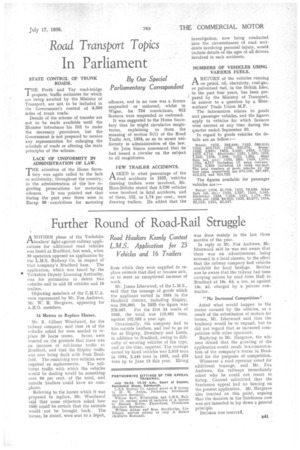Further Round of Road-Rail Struggle
Page 51

If you've noticed an error in this article please click here to report it so we can fix it.
Road Hauliers Keenly Contest L.M.S. Application for 23' Vehicles and 16 Trailers A NOTHER phase of the Yorkshire tihauliers' fight against railway applications for additional road vehicles was heard at Bradford, last week, when 30 operators opposed an application by the L.M.S. Railway Co. in respect of that company's Bradford base. The application, which was heard by the Yorkshire Deputy Licensing Authority, was -for permission to delete two vehicles and -to add 23 vehicles and 16 trailers.
Objecting members of the C.M.U.A. were represented by Mr. Fox Andrews, Mr. W. R. Hargrave, appearing for A.A.O. members.
14 Motors to Replace Horses.
Mr. E. Gilbert Woodward, for the railway company, said that 14 of the vehicles asked for were needed to re place 20 horse teams. Seven were wanted on the grounds that there was an increase of rail-borne traffic at Bradford, and that the Shipley traffic was now being dealt with from Bradford. The remaining two vehicles were
required as replacements. The railborne traffic with which the vehicles would be dealing would be something over 99 per cent, of the total, and outside hauliers could have no complaint.
Referring to the horses which it was proposed to replace, Mr. Woodward said that some objectors asked how they could' be certain that the animals would not be, bronght back. The horses, he stated, were sent to a depot,
from which they were supplied to replace animals that died or became sick, or to meet an exceptional increase of work.
Mr. James Isherwood, of the L.M.S., said that the tonnage of goods which the applicant carted in 1934 in the Bradford district, including Shipley, was 208,000, In 1935 the figure was 223,687. For the first 24 weeks of 1936, the total was 110,001 tons, against 102,059 a year ago.
Occasionally, the company had to hire outside hauliers, and had to go as far as Shipley, Dewsbury and Leeds, in addition to Bradford, owing to difficulty of securing vehicles of the type, and at the time, required. The tonnage carted by hired vehicles was 2,915 tons in 1934, 2,440 tons in 1935, and 424 tons up to June 13 this year. Hiring was done mainly in the last three months of the year. In reply to Mr. Fox Andrews, Mr. Isherwood said he was not aware that there was an advertisement being screened in a local cinema, to the effect that the railway company had vehicles available for local haulage. Neither was he aware that the railway had been carrying onions by road from Hull to Bradford at 10s. 6d. a ton, as against 13s. 4th charged by a private contractor.
"No Increased Competition."
Asked what would happen to the routes covered by the vehicles, as a result of the substitution of motors for horses, Mr. Isherwood said that the tendency would be to expand, but he did not regard that as increased Competition with other operators.
Replying to Mr. Hargrave, the witness denied that the granting of the application would result in a concentration of the company's forces in Bradford for the purposes of competition.
Whenever a road operator asked for additional tonnage, said Mr. Fox Andrews, the railways immediately asked why he could not resort to hiring. Counsel submitted that the Sanderson appeal had no bearing on the present application. Mr. Hargrave also touched on this point, arguing that the decision in the Sanderson case was not intended to lay down .a general principle. Decision was reserved.




















































































